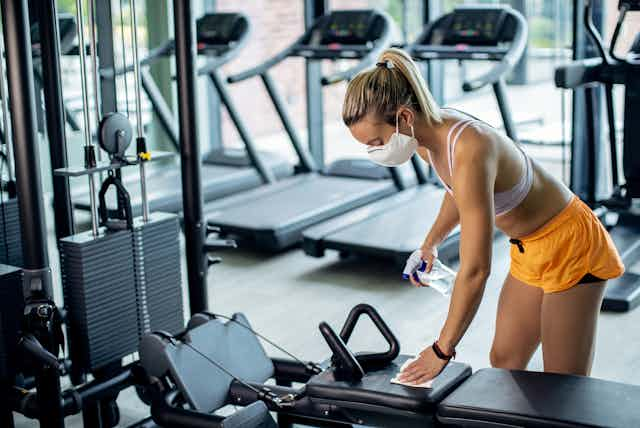Since COVID-19 lockdowns began last year, the sport and recreation industry has been one of the hardest hit. And as we move towards a slow reopening, variants of concern (like the Delta variant) threaten the industry’s safe resumption. Despite vaccination efforts, some say herd immunity is unlikely, and we may have to learn to live with the virus.
In Canada, lockdowns have had negative impacts on levels of physical activity, sedentary behaviour and mental health. And unhealthy lifestyle trends are associated with severe complications from COVID-19 and hospital admissions.
Read more: A year into the pandemic, COVID-19 exercise slump has hit women harder
Sport and recreation facilities help support healthy lifestyles. Throughout the pandemic, however, they’ve become difficult to safely operate because of the elevated respiratory activity and the potential for airborne transmission of the virus. As a result, many have been forced to close or operate under strict guidelines.
Learning to live with the virus must involve considering how to support health and well-being. And strategies need to be developed to mitigate the risk of transmission in sport and recreation facilities.

Mitigating the spread of COVID-19
We looked at peer-reviewed articles to identify recommendations for those involved in designing, managing and working in sport and recreation facilities to help mitigate the risk of COVID-19 transmission — our article is a preprint and currently yet to be peer-reviewed. We categorized recommendations in accordance with the National Institute for Occupational Safety and Health’s (NIOSH) guidelines for addressing occupational hazards, in this case COVID-19.
According to the guidelines, the most protection is offered by eliminating or substituting the hazard from the workplace, implementing engineering controls, adjusting how people work through administrative controls and using personal protective equipment as the last line of defence.
Our analysis resulted in recommendations that will help the sport and recreation industry mitigate the spread of COVID-19. Here is a summary of the recommendations.
Eliminating/substituting the hazard: Mandatory vaccination policy
A mandatory immunization or vaccination passport policy is the safest option.
Given the close proximity people often find themselves in at sport and recreation facilities, this policy should be considered as important as the sport equipment that keeps people safe.
Engineering controls: Altering the built environment
Architects, engineers and facility directors should consider altering the built environment. These facilities often have complex rooms of varying sizes that require improved ventilation and air handling systems.
Rooms and corridors will need to be redesigned so that they allow for physical distancing, and the number of high-touch surfaces within facilities will likely need to be reduced through automation. To improve user hygiene, hand-washing stations should be installed throughout, allowing users to use them before, after and during an activity.
Administrative controls: Standard operating procedures
Facilities operators should develop COVID-19 management plans and integrate them into their standard operating procedures, and health screening will need to be conducted daily for anyone entering the facility.
Rooms, surfaces and equipment will need to be cleaned more frequently, and communication plans will need to be developed that educate and encourage safe user behaviour. The operation of food and beverage services will need to be altered, and items should be individually wrapped in disposable containers. Clinical waste bins will need to be available for potentially contaminated material like used masks, and facilities will need to co-ordinate delivery schedules with their suppliers to minimize contact with facility staff.

Administrative controls: Facility capacity and spacing
General facility capacity will need to be reduced to allow for physical distancing, and travelling throughout a facility will need to be reconsidered to reduce travel distances and contacts.
Because of the moist environment and airborne particles in sport and recreation facilities, lockers should primarily be used as storage and placed where physical distancing can be maintained. Spectator areas will need to implement physical distancing and consider installing partitions between seats.
Administrative controls: Activities and equipment
Return to activity guidelines should be created for each activity and space with public health consultation. Staggering facility scheduling will help minimize unnecessary usage of facilities and personal contacts, and will assist with cleaning. Accommodations will need to be made for populations that are more vulnerable to COVID-19. The sharing of personal items like water bottles or towels must not be permitted.
Administrative controls: Staffing requirements
The staff requirements of facilities and organizations that operate within them will need to change. A COVID-19 supervisor should be appointed to conduct regular health and safety evaluations, and all staff will need to be trained on the new COVID-19 standard operating procedures.
Staff who can complete their tasks at home should be encouraged to do so to reduce the number of occupants within a facility at any time. Facilities should work with community sport organizations and their personnel (like coaches) to develop return to activity guidelines.
Personal protective equipment: The last line of defence
Extra personal protective equipment should be available, and all occupants should be required to wear masks when not engaged in physical activity. Facility staff, coaches, trainers and other personnel should be provided with and wear additional personal protective equipment appropriate for their role.
Read more: The business of sports resumes amid COVID-19, but at what cost?
As we return to some degree of normalcy from the height of the pandemic, the sport and recreation industry will be essential for supporting our health and well-being. Therefore it is crucial that we evaluate the environment of sport and recreation facilities and implement measures that mitigate the risk of transmission so we can all enjoy them again.

